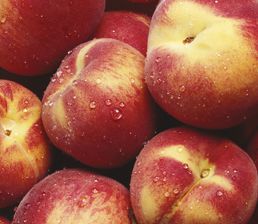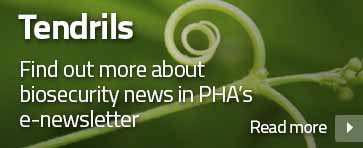 Summerfruit Australia represents the biosecurity interests of summerfruit producers (including apricots, nectarines, peaches and plums) and the industry. They are members of Plant Health Australia and signatories to the Emergency Plant Pest Response Deed. Their responsibilities include:
Summerfruit Australia represents the biosecurity interests of summerfruit producers (including apricots, nectarines, peaches and plums) and the industry. They are members of Plant Health Australia and signatories to the Emergency Plant Pest Response Deed. Their responsibilities include:
- biosecurity planning and implementation at the national and farm levels
- liaising with federal and state governments on trade issues
- funding and supporting biosecurity initiatives
- participating in national committees and response efforts in an emergency.
Industry overview
Nectarines and peaches comprised two thirds of national stone fruit production, followed by plums and apricots. Production is mainly located in subtropical and temperate Australia where the industry is a major rural and regional employer. Victoria produces around 75 per cent of Australia’s stone fruit (138,000 tonnes nationally) with the remaining production spread between New South Wales, Queensland, South Australia, Western Australia and Tasmania.
Increased stone fruit exports have been driven by demand from China. Market access to mainland China allowed an expansion of exports. Other major markets are United Arab Emirates, Saudi Arabia, Singapore and Malaysia.
Biosecurity plans, manuals and resources
Expand
 Industry Biosecurity Plan for the Summerfruit Industry
Industry Biosecurity Plan for the Summerfruit Industry
Biosecurity planning provides a mechanism for the summerfruit industry, government and other relevant stakeholders to assess current biosecurity practices and future biosecurity needs. Planning identifies procedures that can be put in place to reduce the chance of pests reaching our borders or minimise the impact if a pest incursion occurs.
The Industry Biosecurity Plan for the Summerfruit Industry outlines key threats to the industry, risk mitigation plans, identification and categorisation of exotic pests and contingency plans. For a copy, please contact PHA on 02 6215 7700 or email biosecurity@phau.com.au.
 Orchard Biosecurity Manual for the Summerfruit Industry
Orchard Biosecurity Manual for the Summerfruit Industry
The Orchard Biosecurity Manual for the Summerfruit Industry contains information to help producers to implement biosecurity on-farm. Manuals usually contain an overview of biosecurity, fact sheets to identify the high priority pests of a crop, tips on crop management, and how to manage people, vehicles and equipment to minimise biosecurity risks. Manuals also contain a biosecurity self-assessment list, and templates to record pest surveillance records and visitors.
More information about on-farm biosecurity for both plant and livestock producers is available from the Farm Biosecurity website.
Pollination information
Expand
Fact sheets and web links about the pollination of summerfruit crops are listed below. Please be aware that some of the information was developed overseas, and environmental and seasonal variations may occur.
Peaches and nectarines pollination fact sheet, The Pollination Program (Agrifutures Australia and Hort Innovation)
Apricot pollination fact sheet, The Pollination Program (Agrifutures Australia and Hort Innovation)
Plum pollination fact sheet, The Pollination Program (Agrifutures Australia and Hort Innovation)
Honey bees in cherry and plum pollination, NSW Department of Primary Industries
Pests Expand
Exotic pests (not in Australia)
The following is a list of high priority exotic pests of summerfruit. These pests were identified during the development of the Industry Biosecurity Plan for the Summerfruit Industry in consultation with industry, government and scientists. They have been assessed as high priority pests based on their potential to enter, establish, and spread in Australia (eg environmental factors, host range, vectors) and the cost to industry of control measures.
PHA has a range of fact sheets, contingency plans and diagnostic protocols relevant to these pests. Pest risk review documents are also available for some pests. Please contact PHA on 02 6215 7700 or email biosecurity@phau.com.au for more information.
Endorsed National Diagnostic Protocols are available from the National Plant Biosecurity Diagnostic Network webpage.
| Common name | Scientific name | EPPRD Category | Fact sheet | Contingency plan | Diagnostic protocol |
|---|---|---|---|---|---|
| Brown-marmorated stink bug | Halyomorpha halys | FS FS FS | CP | ||
| Glassy-winged sharpshooter | Homalodisca vitripennis | FS FS FS FS FS FS FS | CP CP | DP | |
| Guava fruit fly | Anastrepha striata and Bactrocera correcta | DP DP | |||
| Spongy moths | Lymantria dispar and Lymantria mathura | FS FS FS | CP | DP | |
| Meadow froghopper (meadow spittle bug) | Philaenus spumarius | ||||
| Mexican fruit fly | Anastrepha ludens | FS | DP | ||
| Oriental fruit fly | Bactrocera dorsalis | 2 | FS FS FS FS FS FS FS | DP DP | |
| Plum pox virus | Plum pox virus (Potyvirus) | 2 | FS FS | CP | DP |
| Sapote fruit fly | Anastrepha serpentina | DP | |||
| Spotted wing drosophila | Drosophila suzukii | FS FS FS FS | |||
| Xylella fastidiosa | Xylella fastidiosa including X. fastidiosa subsp. multiplex and pauca | 2 | FS FS FS FS FS FS | CP CP | DP |
Other pests
The following is a list of documents for other exotic and endemic pests of the summerfruit industry. Please note that this is not a complete list of pests: rather it includes pests for which documents exist in the Pest Information Document Database.
Some of the documents presented here are not tailored to the summerfruit industry and are included for information only.
| Common name | Scientific name | EPPRD Category | Fact sheet | Contingency plan | Diagnostic protocol |
|---|---|---|---|---|---|
| Apple maggot | Rhagoletis pomonella | FS FS | DP | ||
| Apple proliferation | Apple proliferation phytoplasma | FS | |||
| Asiatic brown rot | Monilinia polystroma | ||||
| Banana spider mite | Tetranychus piercei | 4 | FS FS | ||
| Brown headed leaf roller | Ctenopseustis obliquana and Ctenopseustis herang | FS | |||
| Brown rot | Monilinia fructigena | 3 | FS FS FS | ||
| Carambola fruit fly | Bactrocera carambolae | FS FS FS FS | DP | ||
| Cassava spider mite | Tetranychus truncatus | FS | |||
| Citrus longicorn beetle | Anoplophora chinensis | FS | CP | ||
| Coconut bug | Amblypelta cocophaga | FS | |||
| Cotton aphid | Aphis gossypii (exotic strains) | FS | |||
| European stone fruit yellows | Candidatus Phytoplasma prunorum | 3 | FS | ||
| False codling moth | Thaumatotibia leucotreta syn Cryptophlebia leucotreta | 2 | FS | CP | |
| Fijian fruit fly | Bactrocera passiflorae | FS | DP | ||
| Fire blight | Erwinia amylovora | 2 | FS | CP | |
| Green headed leaf roller | Planotortrix excessana | FS | |||
| Japanese beetle | Popillia japonica | FS | |||
| Mediterranean fruit fly | Ceratitis capitata | FS | DP | ||
| Melon fruit fly | Zeugodacus cucurbitae | FS | DP | ||
| New Guinea fruit fly | Bactrocera trivialis | 3 | FS FS | DP | |
| Oblique-banded leaf roller | Choristoneura rosaceana | FS | |||
| Omnivorous leaf roller | Platynota stultana | FS | |||
| Orange tortrix | Argyrotaenia citrana syn A. franciscana | FS | |||
| Pacific spider mite | Tetranychus pacificus | FS | |||
| Peach fruit fly | Bactrocera zonata | FS | DP | ||
| Peach rosette mosaic virus | Peach rosette mosaic virus (Nepovirus) | ||||
| Peach twig borer | Anarsia lineatella | FS | |||
| Peach X disease | Candidatus Phytoplasma pruni | 3 | FS | ||
| Plum curculio | Conotrachelus nenuphar | 2 | FS FS | ||
| Plum fruit moth | Cydia funebrana | FS | |||
| Poinsettia thrips | Echinothrips americanus | FS | CP | ||
| Queensland fruit fly | Bactrocera tryoni | FS | DP | ||
| Strawberry spider mite | Tetranychus turkestani | FS | |||
| Tarnished plant bug | Lygus lineolaris | FS FS FS | CP | ||
| Texas root rot | Phymatotrichopsis omnivora (syn Phymatotrichum omnivorum) | 2 | FS FS | ||
| Tomato black ring virus | Tomato black ring virus (Nepovirus) | FS | |||
| Tomato ringspot virus | Tomato ringspot virus (Nepovirus) | FS | |||
| Verticillium wilt | Verticillium dahliae (exotic defoliating strains) | 3 | FS | ||
| Western flower thrips | Frankliniella occidentalis | FS | |||
| Western plant bug | Lygus hesperus | FS |





Recent Comments